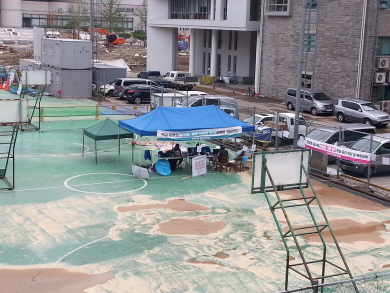
Photo provided by Yonsei Student Government.
Physical facilities, No.1 target for demolition
Last August, the outdoor basketball court of Yonsei University was demolished in order to secure the site for the construction of a new Art Hall. According to the school, the decision was made to prevent potential noises caused by the basketball court that can disturb students studying in the surrounding buildings including the Art Hall.
However, strong resistance from students followed.
“The outdoor basketball court is almost the only court that students can use freely since the indoor court is limited to students majoring in physical education,” said an official from Yonsei’s Student Government Association, Synergy. “Thus, all students who play basketball were using the court all the time. Without the outdoor court, basketball lovers lost their place.”
With a huge student support, the Student Government went into nine days of sit-in demonstrations at the demolition site criticizing the school’s unilateral decision. Over 2500 students signed their signatures to voice their opposition.
“I used to make many friends and precious memories by playing basketball,” said Kim Min-kyu, a junior Yonsei student. “I feel very frustrated that the school made such a decision without enough consultation with students.”
With students’ consistent opposition, the school promised to construct another basketball court near the stadium as a replacement. Student Government officials will be checking the process of the new construction plan “because the school’s words have been untrustworthy so far.”
In 2013, Sogang University’s outdoor basketball court was also torn down, despite the basketball clubs’ opposition.
“There was no other place to construct a new graduate school and student union building,” explained an official of Sogang University. “Such decision does not mean that the school is overlooking the importance of the physical exercise.”
Korea University also tore down its tennis court for the construction of a new Biotechnology building in December last year. Chung-Ang University demolished its basketball court, once famously known as the “Giants Stadium” and Seoul National University also got rid of its supplementary gym for the construction of Woojung Global Social Contribution Center. As these examples demonstrate, physical training facilities are often targeted as the first candidate to be sacrificed for new construction of rather “more practical” buildings.
Reporters: Kim Hye-won, Yang Hae-in, Son Young-chai, Hong Ki-yeon
Ewha Voice
evoice@ewha.ac.kr

